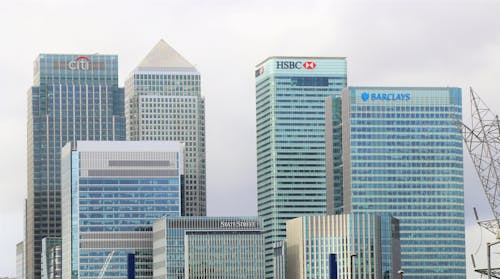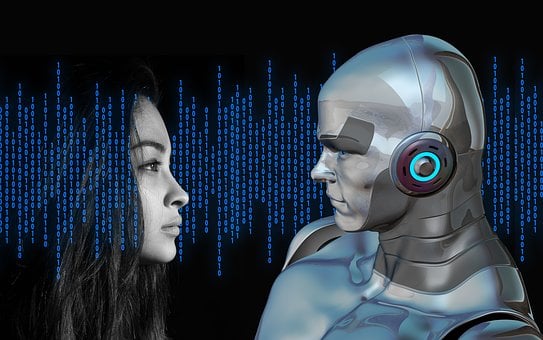AI In Banking: Disrupting the Conventions
 This article was written by the I Know First Research Team.
This article was written by the I Know First Research Team.The rise of the artificial intelligence tech has had a truly transformational effect on multiple industries, from marketing all the way to energy and manufacturing. The financial sector is also going through a transformation, one that came on the back of AI’s surge in the recent years. The arrival of tech-savvy startups has been a disruptor for the traditional segments of the financial world, and banks, as its venerable titans, are no exception. The rise of AI in banking is re-shaping the industry across the board, and if you wonder what this sector may look like tomorrow, with more robots in it, you are in the right place.
AI in Middle Office: Risk Management
According to a whole string of recent reports, banks have been embracing the new technology, introducing it in a whole variety of areas. In fact, a recent report by Business Insider anticipates that by 2023, AI will be saving banks up to $447billion, with its application centered around front and middle office operations.
The first example of AI use in banking that we will point at, however, can generally be used in almost any sphere. JPMorgan Chase has launched its COiN platform, an artificial intelligence designed for quick document processing. The idea is simple and elegant: you let COiN go through those thousands of pages of financial records, and in a second, it comes back to you with all the key points and insights you need.

AI is also used across the board for fraud prevention and anti-money laundering. Here, the idea is relatively straightforward: both are effectively a classification task, with the AI facing a simple question – is this transaction fraudulent or not? Is there anything fishy about it? In finding the answer, it may look at the historical data, or look into the specifics of a transaction, or do both.
Getting ahead of ourselves, we can also note that the same approach can be utilized to classify customers as likely or unlikely to default on a loan. Or, alternatively, an AI can classify an email as benign or an attempted phishing attack. Or it can process troves of data to try and figure out what assets to invest in or sell. All these applications of AI are to a degree connected with the sphere of risk management, which is set to reap the benefits of this exciting technology in the years to come.
AI In Front Office: Facing The Market
On the front office side, AI is already being widely used to connect with the clients through intelligent chatbots. Wells Fargo, one of America’s largest banks, launched a bot that could talk with its customers on Facebook, back in 2017. The bot saved its clients the trouble of going through the bank’s website to find some important information by delivering the same information through a conversational interface.
In a somewhat similar fashion, the Bank of America has unveiled its AI-driven artificial assistant called Erica, which has recently amassed over 6 million users. Erica is a virtual financial assistant who starts off by helping you with simple routine activities, like accessing your account information or transferring money. However, as AI grows more aware of your financial behavior, its functions expand to include financial advice and more. This approach is also vested in the AI-driven assistants launched by the Royal Bank of Canada and Israel’s Discount Bank; their assistants, among other things, offer customers tailored financial insights.
Finally, and most importantly, AI can help the bank’s traders bring in more revenues by assisting them in their investment decisions and streamlining their work. Here, for example, we can point at the Smart Chaser by BNP Paribas, which analyses historical data to predict which trades will need manual intervention by asset managers to be completed. Trade processing overall is a field that is very lucrative for AI implementation, as AIs can help in trade-matching and transaction routing.
Furthermore, artificial intelligence can go further and give traders investment advice based on the trading signals it has found in the market. With this area being one of the more challenging and promising tasks for machine learning, we will discuss it next in-depth in a separate section.
AI In Investment Management
There have already been a few attempts to train AIs that would be able to predict the price dynamics for various assets. Among them is an AI designed by an Israeli-based company called I Know First, which delivers daily forecasts for over 10 000 financial instruments, including stocks, ETFs and currencies. Trained on a historical dataset covering 15 years of trading, it views the markets from a holistic perspective, looking for signals in the fresh trading data and using those to model what happens next on the market. The idea is to establish a pattern and make use of it to identify the direction in which the price for the assets in a specific universe is most like to fluctuate in next, as well as the expected intensity of its swings.

The forecasts are presented as a heatmap with two numeric indicators: signal and predictability. Signal shows how a given asset is expected to perform against others on the list. Predictability, in its turn, demonstrates how successful the algorithm has been in predicting the asset before. Thus, top investment opportunities can be identified by picking out the stocks with the highest values for both indicators. This would help the bank’s traders to identify the most promising assets to invest in and, accordingly, generate more revenue for the bank. The predictability indicator also helps in assessing the risks of an investment portfolio.
The algorithm can easily adapt to new market conditions by virtue of incorporating some features of genetic coding. In other words, it keeps track of its own performance and updates its predictive models as soon as they start to lose their bite. This also ensures that the prediction accuracy goes up after every iteration.
The AI also draws on chaos theory to account for market volatility. It delivers its forecasts for time horizons ranging from 3 to 365 days, covering short, medium and long-term perspectives, which helps the traders to identify opportunities both for a quick profit from short trading and find the stocks that would generate most value over time.














